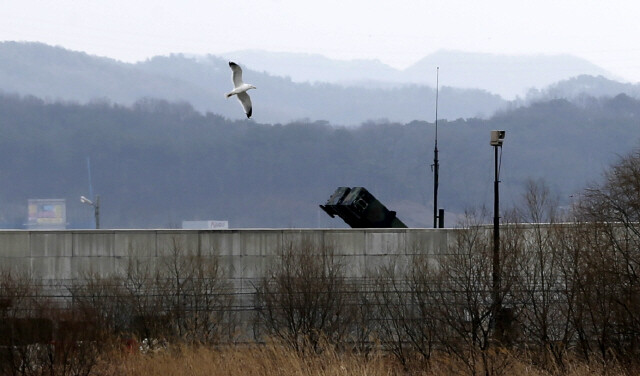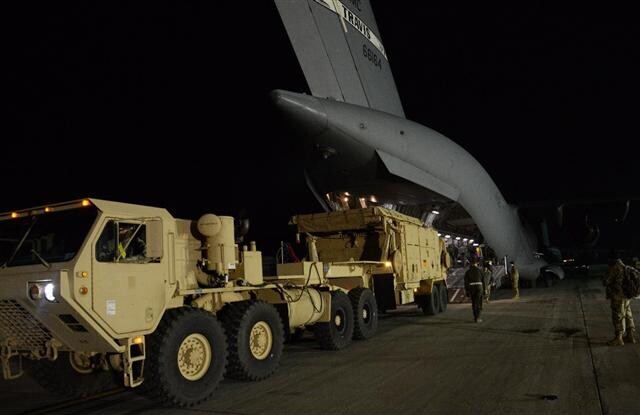hankyoreh
Links to other country sites 다른 나라 사이트 링크
Leaks appear intended to burnish positive opinion over THAAD

The South Korean and US militaries are secretly leaking information to the media that exaggerates North Korea’s missile threat while publicly showing a tough military response to North Korea, including the deployment of an additional Patriot battery. These could be diversionary tactics designed to manipulate the media and to justify the deployment of THAAD with US forces in South Korea.
THAAD, which stands for Terminal High Altitude Area Defense, is an anti-ballistic missile system developed by the US.
On Feb. 14, a number of South Korean newspapers quoted an anonymous government source as saying that the North Korean military had recently set up the “KN-08 Brigade,” a mobile ICBM unit, under the strategic force that commands its missile units.
But when reporters contacted the press office of South Korea’s Joint Chiefs of Staff to confirm the report, the press officer effectively denied it. “While such a possibility cannot be ruled out, we have not heard any information of the sort,” the officer said.
This kind of “hit and run” tactic - leaking sensitive information that would be awkward to openly released to the media and then officially denying it - appears to be an underhanded attempt to shift public opinion by using the media to foster de facto acceptance of dubious claims.
In fact, reports about the KN-08 Brigade also appeared in Oct. 2014. At the time, the Kukmin Ilbo newspaper quoted a source in the South Korean military as saying that there were four brigades under the North Korea military’s strategic command that were in charge of Scud, Rodong, Musudan and KN-08 missiles.
Even worse, the KN-08 missile is an ICBM (intercontinental ballistic missile) that the US and South Korean militaries estimate as having a range of 10,000 kilometers. Thus, it has nothing to do with calls to deploy THAAD with USFK.
The KN-08 missile was first shown to the public at a military parade marking the birthday of North Korean founder Kim Il-sung on Apr. 15, 2012, loaded on a large Chinese-made mobile missile launcher with 16 wheels. When the Chinese company that had made the launcher was accused of violating a UN Security Council resolution, the company claimed that it had sold North Korea six vehicles for the purpose of transporting lumber.
Considering that tightened UN surveillance has forced China to clamp down on the shipment of such weapons to North Korea, it would presumably not have been easy for Pyongyang to acquire more of these launchers.
On the previous day, USFK released a press release in which it announced that another battery of Patriot (PAC-3) missile interceptors had been deployed to South Korea.

PAC-3 is a “lower-tier,” or low-altitude, defense system designed to intercept missiles up to 40km away. When paired with the “upper-tier” THAAD system, which targets missiles at a range of 40km to 150km, it is supposed to create a multi-tier missile defense system.
This was reportedly the first time that USFK has deployed an extra PAC-3 battery to South Korea for training. This unprecedented military activity is presumably aimed at creating a mood that will provide direct and indirect support for the recent decision to deploy THAAD with USFK.
USFK already has deployed two PAC-3 battalions at sites including Osan Air Base. The PAC-3 unit that will be deployed to South Korea is D Battery, a battalion from the 43rd Air Defense Artillery Regiment with the 11th Air Defense Artillery Brigade at Fort Bliss in Texas, USFK said.
The extra PAC-3 battalion that will be deployed to South Korea will not be stationed there permanently, but will return to the US after completing its defense training with the 35th Air Defense Artillery Regiment at OSAN, said an official with USFK.
The US and South Korea have already announced plans to carry out their largest ever joint military exercises - known as Key Resolve/Foal Eagle - from Mar. 7 to Apr. 30.
The US military is considering the idea of including a carrier strike group (composed of a nuclear-powered carrier, nuclear-propelled submarines and Aegis guided missile cruisers) and stealth aircraft such as the F-22 and B-2 in the exercises, reports say. While this is being described as a show of force against North Korea, the increasing military tensions between North and South Korea are having the effect of blurring the debate about THAAD.
By Park Byong-su, senior staff writer
Please direct questions or comments to [english@hani.co.kr]

Editorial・opinion
![[Column] Has Korea, too, crossed the Rubicon on China? [Column] Has Korea, too, crossed the Rubicon on China?](https://flexible.img.hani.co.kr/flexible/normal/500/300/imgdb/original/2024/0419/9317135153409185.jpg) [Column] Has Korea, too, crossed the Rubicon on China?
[Column] Has Korea, too, crossed the Rubicon on China?![[Correspondent’s column] In Japan’s alliance with US, echoes of its past alliances with UK [Correspondent’s column] In Japan’s alliance with US, echoes of its past alliances with UK](https://flexible.img.hani.co.kr/flexible/normal/500/300/imgdb/original/2024/0419/2317135166563519.jpg) [Correspondent’s column] In Japan’s alliance with US, echoes of its past alliances with UK
[Correspondent’s column] In Japan’s alliance with US, echoes of its past alliances with UK- [Editorial] Does Yoon think the Korean public is wrong?
- [Editorial] As it bolsters its alliance with US, Japan must be accountable for past
- [Guest essay] Amending the Constitution is Yoon’s key to leaving office in public’s good graces
- [Editorial] 10 years on, lessons of Sewol tragedy must never be forgotten
- [Column] A death blow to Korea’s prosecutor politics
- [Correspondent’s column] The US and the end of Japanese pacifism
- [Guest essay] How Korea turned its trainee doctors into monsters
- [Guest essay] As someone who helped forge Seoul-Moscow ties, their status today troubles me
Most viewed articles
- 1[Column] The clock is ticking for Korea’s first lady
- 2Hong Se-hwa, voice for tolerance whose memoir of exile touched a chord, dies at 76
- 3After 2 months of delayed, denied medical care, Koreans worry worst may be yet to come
- 4[Column] Has Korea, too, crossed the Rubicon on China?
- 5US overtakes China as Korea’s top export market, prompting trade sanction jitters
- 6Samsung barricades office as unionized workers strike for better conditions
- 7[Correspondent’s column] In Japan’s alliance with US, echoes of its past alliances with UK
- 8All eyes on Xiaomi after it pulls off EV that Apple couldn’t
- 9[Correspondent’s column] The US and the end of Japanese pacifism
- 10[Guest essay] How Korea turned its trainee doctors into monsters